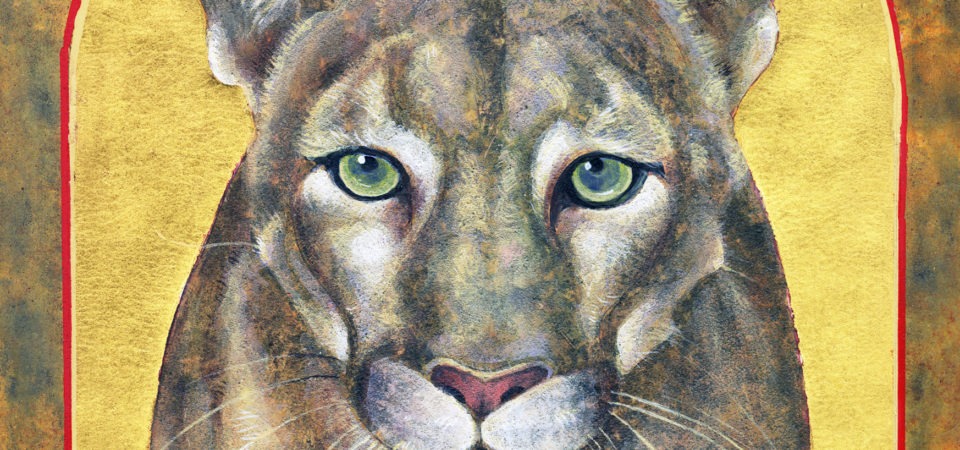Angela Manno – The Florida Panther (detail), 2019, 7” x 9” Egg tempera & gold leaf on wood – Angela Manno ©2019
“There is much consideration of the physical and biological modes of survival with relatively little comment on the soul of the future. Here we are mainly concerned with the ‘soul’ as the shaping spirit within any vital process. These, the inner spirit and the outer form, are two distinctive aspects of a single mode of being. In considering the soul of the future, I am concerned with the inner vision that we need if we are to make the intellectual, social, economic, and religious adjustments required for a viable future.” — Thomas Berry
As an artist, environmental activist and lover of the world, my aim is to touch the hearts of my viewers and expand human consciousness. It has always been so, although today, it is an urgent task, because we need a metanoia — a complete change of heart, mind and way of life — and to transition as quickly as possible from toxic anthropocentrism towards a biocentric norm of reference.
I am concerned with the soul of this moment, the “inner vision” that guides our behavior, both the terminal industrial vision that is turning our world into a wasteland as well as the one that created the complex Human Predicament map and that has set in motion a wealth of solutions. These visions are the context of both the new Earth we strive to bring forth, as well as the one that is being destroyed.
What is behind this effort to tackle all these complex interrelated issues? The survival instinct? The dream of “sustainability”? Fear? Is it love? A vision of a regenerative human presence on the planet? A knowing that Beauty is the true state of our being?
You might call what I’ve been up to for the past forty years, the art of seduction through the image. MAHB is rare for putting great value on and recognizing the power of visual art to influence society, for since the early 19th century — about one hundred years — with the concept of “art for art’s sake” (the only true art must be divorced from any moral or social function), visual art has been bound, gagged and neutered, restrained from its higher calling.
Never having been indoctrinated in this manner, I have always been free to make my art according to what fascinates me. And what fascinates me is Beauty in Nature and in all other things. The kind of Beauty that is implicit in health and well being, in goodness, in harmony, balance, good will and happiness.
Beauty seen this way helps us feel the interrelatedness of all things, from the human mind to ecosystems and galaxies, and to approach everything with kindness and understanding. The new paradigm that will save and heal this world is based in a deep understanding of systems. Not one of the nodes on the Human Predicament map exists unrelated to all the others and any solution to one of them will impact all the others. This is why it brilliantly shows the connections between every one.
My own artwork has gone through a number of phases to convey these feelings and ideas. My 13-piece mixed media series, “Conscious Evolution: The World At One,” which is now part of the permanent fine art collection of the Smithsonian Institute’s National Air & Space Museum, presented the big picture, beginning with the revelations many astronauts had when seeing the Earth from space. One East German cosmonaut put it this way,
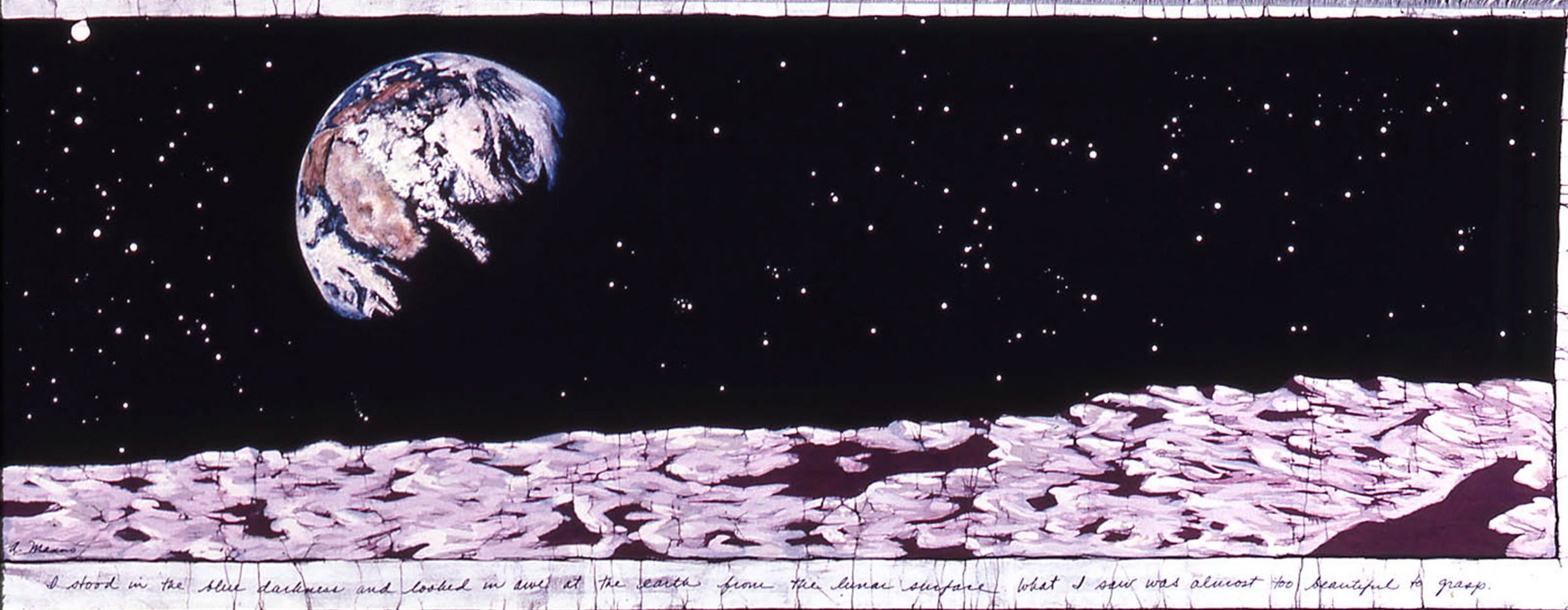
I Stood on the Lunar Surface
46” x 20” Batik and color Xerox.
Collection of the National Air & Space Museum, Washington , D.C.
The quotation on the bottom, by Eugene Cernan, the last man to walk on the moon, inspired this piece.
“Before I flew I was already aware of how small and vulnerable our planet is, but only when I saw it from space, in all its ineffable beauty and fragility, did I realize that humankind’s most urgent task is to cherish and preserve it for future generations.”
The medium used in the series — a combination of color Xerox, a contemporary art form, with batik, the ancient medium of textile design — conveyed my message in a formal way of the artful synthesis of ancient wisdom and the tools of modern technology. After the epiphany of seeing the Earth from a distance, the subsequent pieces address the multiform relationships that exist on the planet: intra-personal, interpersonal, human-Earth, and human-cosmic.
In 1998, my life changed dramatically when I moved to the high desert in Southern Colorado and began three simultaneous courses of study: Earth Literacy, plein air landscape painting and Byzantine Russian iconography. These three formative experiences, combined with my connection to the American Indians of the Southwest, became the seed for all of my subsequent work.
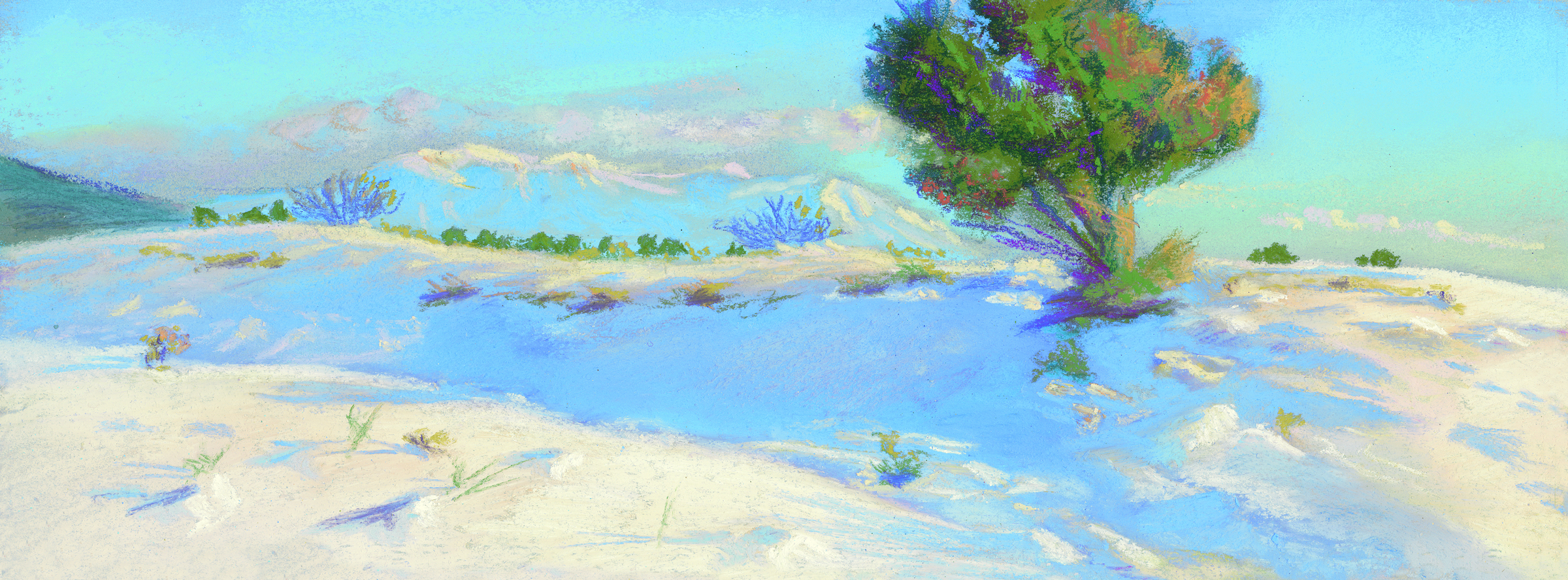
White Silence
4.5″ x 12″
Pastel on Paper
Underlying seemingly divergent practices: plein air painting and Byzantine Russian iconography, one using a relatively modern medium — pastel — and the other, an ancient medium — egg tempera and gold leaf — was an experience of sublime beauty.
The experience of painting outdoors, immersed in your subject matter, and the daunting task, quote Monet, to “look at what the universe has shown me and bear witness to it with my brush” often began with the Navajo invocation, “Beauty before me, Beauty behind me, Beauty all around me.”
In a more codified way, the practice of traditional iconography is an experience of Beauty in the natural materials used: clay, marble dust, chalk, egg yolk and tempera paints, made from earth pigments and ground up semiprecious stones. They are considered to be “windows to the Divine,” which to me means the ground of Being, the ultimate Beauty — in essence, the soul of this world.
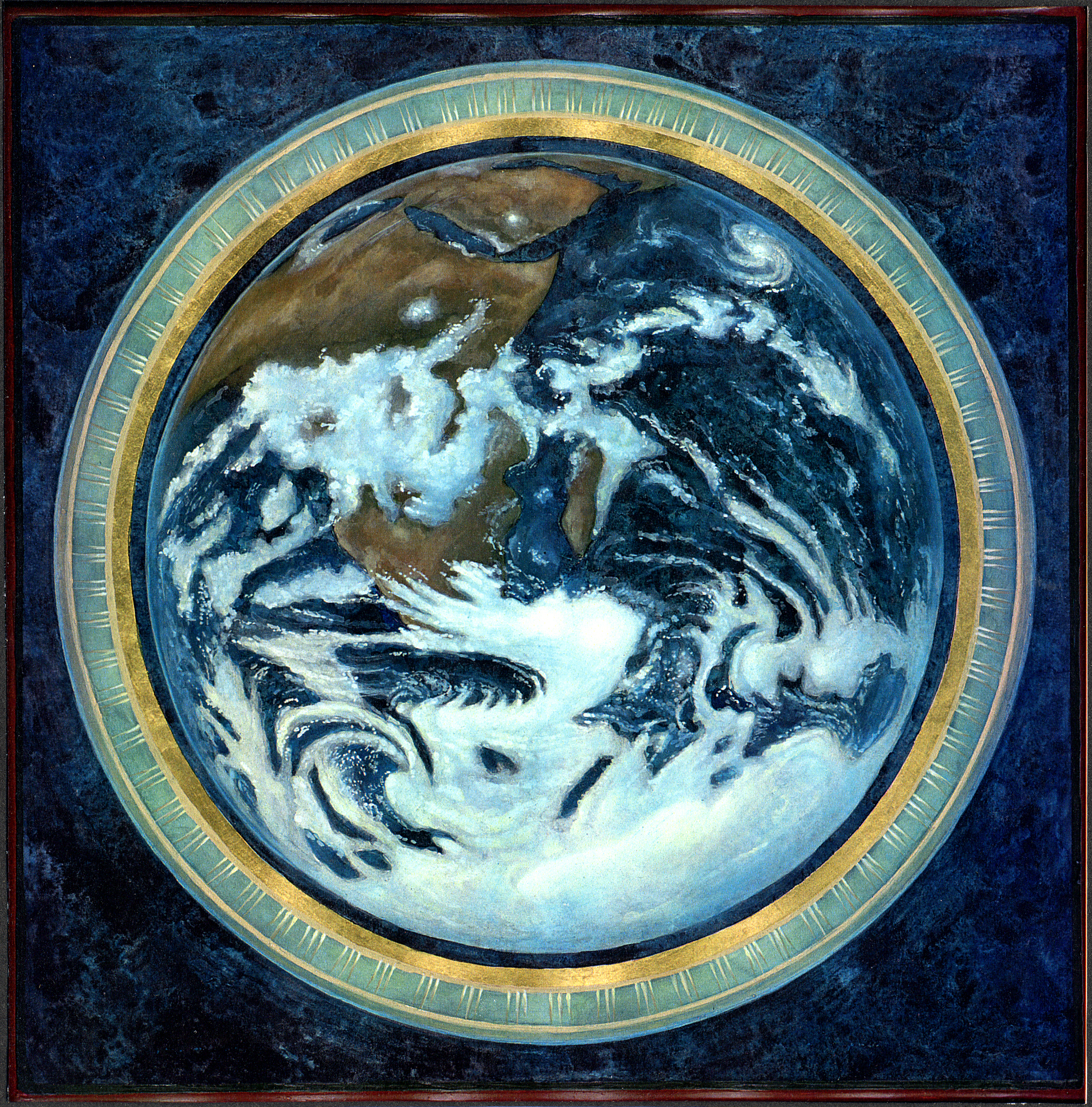
The Earthly Paradise: Icon of the Third Millennium
13” x 13”
Egg tempera & gold leaf on wood
Private Collection
But soon into the practice, because of my Earth Literacy studies, I began to feel limited by the traditional canon of images, and the need for a new icon, of the Being that underlies all others — that of the the planet Earth itself. So in 2000 I completed The Earthly Paradise: Icon of the Third Millennium, which elevates the Earth itself to the status of an icon, to be revered as much as any being that is derivative of her.
The following years found me engaged in two sacred practices: icon painting and environmental activism. It began in the high desert, where the local community rose up against the Colorado Air National Guard who were secretly planning to do air to air combat training over our heads in one of the most pristine wildlife refuges inhabited by humans, the San Luis Valley. We were triumphant in getting to leave. Once back on the East Coast, I joined anti-fracking groups who succeeded in getting fracking banned from New York State.
During all this turmoil, I became aware of the holocaust of Nature taking place at an alarming rate. This is when I began my series of “Sacred Icons of Endangered Species.” 50 percent of the sale of each original icon benefits the Center for Biological Diversity, which is another form of activism. I will let the following images speak for themselves.
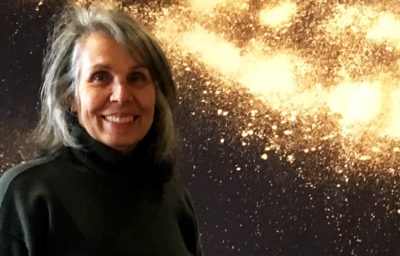 Angela Manno is an internationally exhibited artist, activist and educator. Her art has been exhibited in museums from Mexico City to Moscow and resides in private collections throughout the Americas, Europe, the Middle East and Southeast Asia. Distinguished venues to exhibit her work include the National Museum of Women in the Arts, the Smithsonian Institution and the American Museum of Natural History. Her works are part of the permanent fine art collections of NASA and the National Air & Space Museum in Washington, D.C.
Angela Manno is an internationally exhibited artist, activist and educator. Her art has been exhibited in museums from Mexico City to Moscow and resides in private collections throughout the Americas, Europe, the Middle East and Southeast Asia. Distinguished venues to exhibit her work include the National Museum of Women in the Arts, the Smithsonian Institution and the American Museum of Natural History. Her works are part of the permanent fine art collections of NASA and the National Air & Space Museum in Washington, D.C.
Alongside her work as a professional artist, Angela has been active on campaigns to rid pristine wilderness and densely populated areas from military presence. She was part of the successful campaign to get fracking banned from the State of New York.
As an educator, Angela has created a 90-minute slide presentation “Picturing the Ecological Age” and Eco-spirituality & Action, a semester-long course which led to the 2007 “Peace With Earth” declaration of New York Quakers.
Angela’s artwork has been noted in numerous publications including The Progressive, National Catholic Reporter, ArtNews, and a nine-page spread in The Artful Mind, the premier art magazine of the Berkshires.
This article is part of the MAHB Arts Community‘s “More About the Arts and the Anthropocene”. If you are an artist interested in sharing your thoughts and artwork, as it relates to the topic, please send a message to Michele Guieu, Eco-Artist and MAHB Arts Community coordinator: michele@mahbonline.org. Thank you. ~

